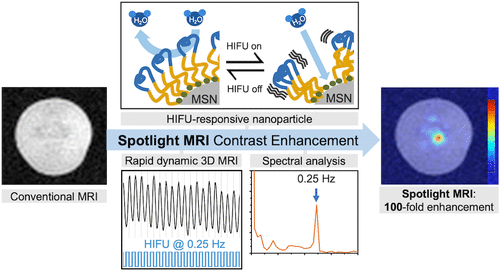Our official English website, www.x-mol.net, welcomes your
feedback! (Note: you will need to create a separate account there.)
Responsive Nanoparticles to Enable a Focused Ultrasound-Stimulated Magnetic Resonance Imaging Spotlight
ACS Nano ( IF 15.8 ) Pub Date : 2021-09-14 , DOI: 10.1021/acsnano.1c04339 Tian Deng 1, 2 , Le Zhang 3 , Xinzhou Li 3, 4 , Jeffrey I Zink 1, 2 , Holden H Wu 2, 3, 4
ACS Nano ( IF 15.8 ) Pub Date : 2021-09-14 , DOI: 10.1021/acsnano.1c04339 Tian Deng 1, 2 , Le Zhang 3 , Xinzhou Li 3, 4 , Jeffrey I Zink 1, 2 , Holden H Wu 2, 3, 4
Affiliation

|
Magnetic resonance imaging (MRI)-guided high-intensity focused ultrasound (HIFU) has been applied as a therapeutic tool in the clinic, and enhanced MRI contrast for depiction of target tissues will improve the precision and applicability of HIFU therapy. This work presents a “spotlight MRI” contrast enhancement technique, which combines four essential components: periodic HIFU stimulation, strong modulation of T1 caused by HIFU, rapid MRI signal collection, and spotlight MRI spectral signal processing. The T1 modulation is enabled by a HIFU-responsive nanomaterial based on mesoporous silica nanoparticles with Pluronic polymers (Poloxamers) and MRI contrast agents attached. With periodic HIFU stimulation in a precisely defined region containing the nanomaterial, strong periodic MRI T1-weighted signal changes are generated. Rapid MRI signal collection of the periodic signal changes is realized by a rapid dynamic 3D MRI technique, and spotlight MRI spectral signal processing creates modulation enhancement maps (MEM) that suppress background signal and spotlight the spatial location with nanomaterials experiencing HIFU stimulation. In particular, a framework is presented to analyze the trade-offs between different parameter choices for the signal processing method. The optimal parameter choices under a specific experimental setting achieved MRI contrast enhancement of more than 2 orders of magnitude at the HIFU focal point, compared to controls.
中文翻译:

响应纳米粒子使聚焦超声刺激磁共振成像聚光灯成为可能
磁共振成像(MRI)引导的高强度聚焦超声(HIFU)已作为治疗工具应用于临床,增强MRI对比度对靶组织的描绘将提高HIFU治疗的准确性和适用性。这项工作提出了一种“聚光 MRI”对比度增强技术,它结合了四个基本组成部分:周期性 HIFU 刺激、由 HIFU 引起的 T 1强调制、快速 MRI 信号收集和聚光 MRI 光谱信号处理。T 1调制由基于介孔二氧化硅纳米粒子的 HIFU 响应纳米材料实现,并附有 Pluronic 聚合物(泊洛沙姆)和 MRI 造影剂。在包含纳米材料的精确定义区域中进行周期性 HIFU 刺激,强周期性 MRI T产生1加权信号变化。周期性信号变化的快速 MRI 信号收集是通过快速动态 3D MRI 技术实现的,聚光 MRI 光谱信号处理创建调制增强图 (MEM),抑制背景信号并通过纳米材料经历 HIFU 刺激来突出空间位置。特别是,提出了一个框架来分析信号处理方法的不同参数选择之间的权衡。与对照组相比,特定实验设置下的最佳参数选择在 HIFU 焦点处实现了超过 2 个数量级的 MRI 对比度增强。
更新日期:2021-09-28
中文翻译:

响应纳米粒子使聚焦超声刺激磁共振成像聚光灯成为可能
磁共振成像(MRI)引导的高强度聚焦超声(HIFU)已作为治疗工具应用于临床,增强MRI对比度对靶组织的描绘将提高HIFU治疗的准确性和适用性。这项工作提出了一种“聚光 MRI”对比度增强技术,它结合了四个基本组成部分:周期性 HIFU 刺激、由 HIFU 引起的 T 1强调制、快速 MRI 信号收集和聚光 MRI 光谱信号处理。T 1调制由基于介孔二氧化硅纳米粒子的 HIFU 响应纳米材料实现,并附有 Pluronic 聚合物(泊洛沙姆)和 MRI 造影剂。在包含纳米材料的精确定义区域中进行周期性 HIFU 刺激,强周期性 MRI T产生1加权信号变化。周期性信号变化的快速 MRI 信号收集是通过快速动态 3D MRI 技术实现的,聚光 MRI 光谱信号处理创建调制增强图 (MEM),抑制背景信号并通过纳米材料经历 HIFU 刺激来突出空间位置。特别是,提出了一个框架来分析信号处理方法的不同参数选择之间的权衡。与对照组相比,特定实验设置下的最佳参数选择在 HIFU 焦点处实现了超过 2 个数量级的 MRI 对比度增强。











































 京公网安备 11010802027423号
京公网安备 11010802027423号